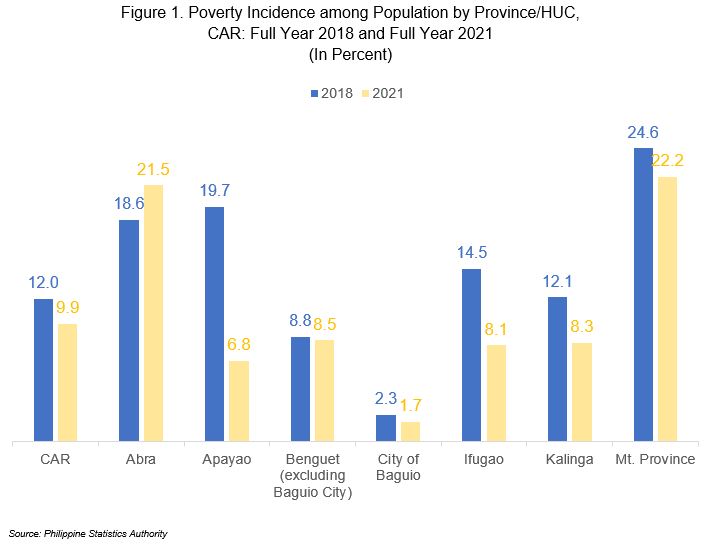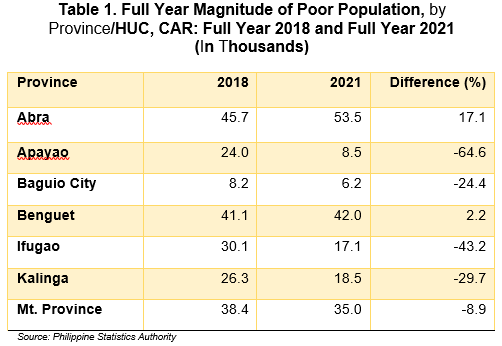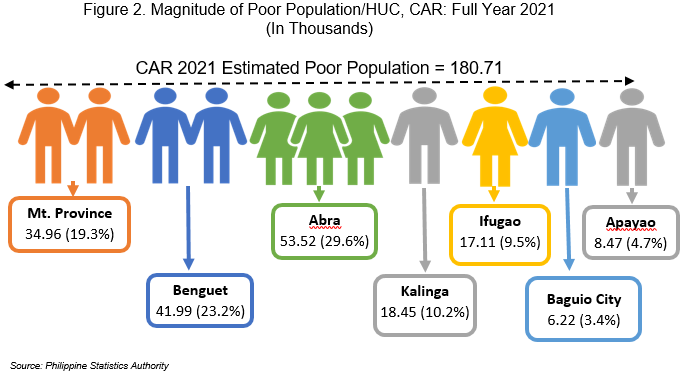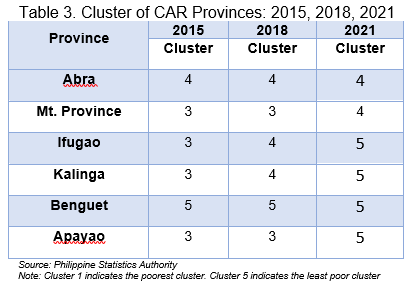Nearly 10 out of 100 individuals in CAR are poor
- The poverty incidence among population in CAR in 2021 was estimated at 9.9 percent. This implies that in 2021, nearly 10 in every 100 individuals in the region belong to the poor population whose incomes were not sufficient to purchase minimum basic food and non-food needs or below the poverty threshold. In comparison to 2018 with a record of 12.0 percent, a decrease of 2.1 percentage points was posted.
- In between 2018 and 2021, significant improvements in poverty incidence among population in Apayao, Benguet, City of Baguio, Ifugao, Kalinga, and Mountain Province were recorded. Apayao recorded the most significant improvement in CAR with a drop of 12.9 percentage points, from 19.7 percent in 2018 to 6.8 percent in 2021. Meanwhile, the province of Benguet registered 8.5 percent in 2021 which was lower than the 8.8 percent in 2018.
- The City of Baguio posted the lowest poverty incidence among population in CAR with 1.7 percent. Meanwhile, provinces of Ifugao, Kalinga, and Mountain Province registered 8.1 percent, 8.3 percent, and 22.2 percent, respectively.
- On the other hand, poverty incidence among population in Abra significantly increased to 21.5 percent in 2021 from 18.6 percent in 2018 (Figure 1).
Poor population in CAR declines by 33,120
- The number of poor individuals in CAR was estimated at 180,710 in 2021. This was 33,120 lesser than the 2018 record of 213,830.
- Notable decreases were recorded from provinces of Apayao and Ifugao. In 2021, poor individuals from Apayao were posted at 8,500, from 24,000 in 2018. Ifugao listed a 13,000 decrease in 2021 with 17,100, from 30,100 in 2018. Baguio City once again had the lowest number of poor individuals with only 6,200 in 2021. Provinces of Kalinga and Mountain Province were able to reduce their number of poor individuals with 18,500 and 35,000 poor individuals, respectively (Table 1).
- However, the magnitude of poor population soared in provinces of Abra and Benguet. An increase of 7,800 poor individuals in Abra were listed in 2021 resulting to a total of 53,500 poor individuals. Meanwhile, Benguet added 900 poor individuals in 2021 resulting to 42,000 poor individuals.
Abra, Baguio City hold their positions
- In 2021, Abra maintained its rank as the province with the highest poor individuals in CAR. Similar to what happened to Benguet, it was still the second province with highest rate of poor individuals both in 2018 and 2021. Mountain Province came in third, Kalinga grabbed the fourth highest number of poor individuals while Ifugao claimed the fifth rank.
- As for the province that posted the highest decline in number of poor individuals, Apayao was the sixth of the seven provinces and HUC with the highest magnitude of poor population in Cordillera. Baguio City also lessened the number of poor individuals yet was still considered as the least poor province in the Cordillera region (Table 1).
Most poor individuals are from Abra
- In 2021, an estimate of 53,520 poor individuals in CAR were from Abra. This was followed by approximately 41,990 poor individuals in Benguet and 34,960 in Mountain Province.
- Moreover, in Kalinga, there were about 18,450 poor individuals, followed by Ifugao with about 17, 110, Apayao with about 8,470, and Baguio City with the least poor population with an estimate of 6,220 poor individuals.
Apayao enters least poor cluster
- In 2021, two provinces of CAR were in Cluster 4 and four provinces were in Cluster 5 that is the least poor cluster.
- The provinces that belong to Cluster 4 were Abra and Mountain Province. Abra was consistently placing in Cluster 4 since 2015 until 2021. Meanwhile, with lesser poor population, Mountain Province was able to enter Cluster 4 in 2021 after being in Cluster 3 in 2015 and 2018.
- Ifugao and Kalinga were continuously declining their number of poor individuals since 2015 to 2021. From being in Cluster 3 in 2015, they moved to Cluster 4 in 2018, and they moved to the least poor cluster in 2021.
- Benguet was consistent for being considered in the least poor cluster of provinces as it belonged to Cluster 5 from 2015 to 2021. Joining Benguet in Cluster 5 was Apayao. In both years, 2015 and 2018, Apayao was in Cluster 3.
Technical Notes
Family - a group of persons usually living together and composed of the head and other persons related to the head by blood, marriage or adoption. It includes both the nuclear and extended family.
Family Expenditures - The expenses or disbursements made by the family purely for personal consumption during the reference period. These include: - Total value of all items of consumption/expenditure bought on credit during the reference period as well as services availed of within the same period that have not been fully paid at the time of visit. - Value consumed from gifts, support, assistance or relief in goods and services received by the family from friends, relatives and imputed rent of owner-occupied dwelling unit. '- Gifts, support, assistance or relief in goods and services donated by the family to friends, relatives and others like tithes, contribution to church, etc. - Imputed value of goods/ services received as fringe benefits from employer or part of the salaries/wages of employed family members.
Family Income - The primary income and receipts from other sources received by all family members during the reference period, as participants in any economic activity or as recipients of transfers, pensions, grants, interests, food and non-food items received as gifts by the family. Primary income includes: - Salaries and wages from employment - Commissions, tips, bonuses, family and clothing allowance, transportation and representation allowance and honoraria - Other forms of compensation and net receipts derived from the operation of family-operated enterprises/activities and the practice of a profession or trade Income from other sources includes: - Imputed rental values of owner-occupied dwelling units - Interests - Rentals including landowner’s share of agricultural products - Pensions, royalties and dividends from investments - Gifts, support in any form (physical, material and financial) and the value of food and non-food items received as gifts by the family (as well as the imputed value of services rendered free of charge to the family). - Cash received out of salaries/wages and other sources of income of a family member who is a contract worker abroad and also cash receipts sent by a family member/relative of the household with a status of residency abroad other than that of a contract worker - Receipts from family sustenance activities, which are not considered as family operated enterprise.
Food threshold - the minimum income/expenditure required for a family/individual to meet the basic food needs, which satisfies the nutritional requirements for economically necessary and socially desirable physical activities.
Subsistence incidence - the proportion of families/individuals with per capita income/expenditure less than the per capita food threshold to the total number of families/individuals
Poverty Threshold is the minimum income/expenditure required for a family/individual to meet the basic food and non-food requirements.
Poverty Incidence refers to the proportion of families/individuals with per capita income/expenditure less than the per capita poverty threshold to the total number of families/individuals
Poverty Incidence among Population is the proportion of people below the poverty line to the total population.
Notes: Basic food requirements are currently based on 100% adequacy for the Recommended Energy and Nutrient Intake (RENI) for protein and energy equivalent to an average of 2000 kilocalories per capita, and 80% adequacy for other nutrients. On the other hand, basic non-food requirements, indirectly estimated by obtaining the ratio of food to total basic expenditures from a reference group of families, cover expenditure on: 1) clothing and footwear; 2) housing; 3) fuel, light, water; 4) maintenance and minor repairs; 5) rental of occupied dwelling units; 6) medical care; 7) education; 8) transportation and communication; 9) non-durable furnishings; 10) household operations; and 11) personal care and effects.
_____________________________________________________________________________





